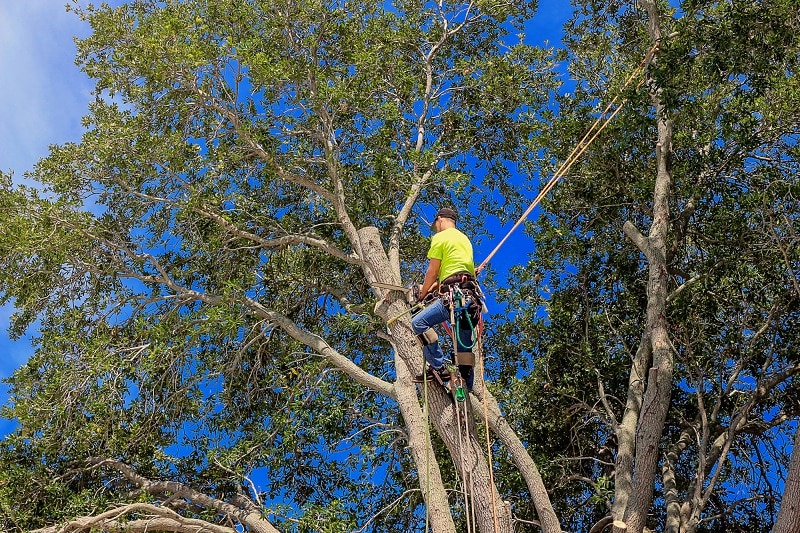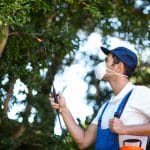Tree Pruning
Tree pruning is a critical practice in tree maintenance, where arborists selectively remove specific parts of the tree, such as branches, buds, or roots.
By doing so, arborists improve the structure and health of the trees and ensure public and infrastructural safety. Enhancing the tree’s beauty is also another serious benefit.
When it comes to tree service methods and equipment, there are several tactics arborists use. Depending on the tree’s species, location, structure, and objectives, they may use some or all of the following techniques.
Canopy Thinning
Canopy thinning is a technique that arborists use to reduce the bulkiness of a tree. It also improves air circulation and allows more light penetration.
They remove selected branches and leaves from specific parts or all of the crown using specialized power pruners, hand-held secateurs, or pruning saws. Canopy thinning ensures that the tree doesn’t experience any trauma or excessive bleeding during the pruning process.
Dead Wooding
Dead wooding, as the name suggests, involves removing dead, dying, diseased, or decaying branches from a tree’s canopy. Dead branches on a tree provide a home and entry site for insects and fungi. This slows the tree’s growth and makes it vulnerable to decay and structural defects.
Arborists selectively prune branches to reduce the chances of the tree posing any threats to people or property. They remove these branches using chainsaws, pole pruners, or harnesses, depending on the branches’ location.
Crown Cleaning
Crown cleaning focuses on removing unwanted and unnecessary vegetation, such as abnormal or hazardous branches, water sprouts, suckers, or pests from the tree’s crown. Crown cleaning eliminates any debris or hazards developing in the tree that could harm its growth or compromise its beauty. The crown of a tree is where most of its leaves and canopy are.
This leaves a more attractive and structurally sound tree. This technique also helps in identifying possible future tree problems or potential decay on the remaining part of the tree.
Crown Raising
Crown raising is the last method arborists use in tree pruning, involving the selective removal of the low-hanging branches or those that increase street traffic or road clearance issues and contribute to making bumping inconvenient. Crown raising ensures better clearance from foliage obstructions and improves vehicle parking and access.
Tree Removal: When Trees Pose a Danger
Trees occupy an essential part of any property’s garden. Despite this fact, it may become necessary to remove trees, particularly if they pose any danger to public infrastructure or buildings or if weather conditions occasionally damage them.
Arborists determine the need for tree removal by evaluating several factors, including the tree’s structure, signs of weakening, insect damage, disease, poor structure, disruptive root systems, deadwood, and bad infestation.
Equipment Used in Tree Service
Arborists in their line of work also rely on specialized tools, equipment, and machines to perform their job. Professional-grade tools make arborists’ work more efficient and allow for quicker execution.
Chainsaws are probably the most well-known equipment in arboriculture. They are used in tree felling, pruning, and removing tasks. Arborists regularly maintain their chainsaws for efficient best-practice handling in assessing the chains’ sharpness, fueling levels, air filter maintenance, and other mechanical parts.
Ladders assist in accessing different parts of a tree, especially the low-hanging branches that cannot be reached by telescopic pruners.
Pruning shears are necessary because they allow for the removal of smaller branches and plants. They can also help with clearing deadwood. The long handle pruning shear assists in pruning trees, instead of using more intrusive measures.
Stump grinders are an essential utility that assist in removing or de-sizing tree stumps. Stump grinders used by arborists are industrial machines utilized to grind down stumps and prep the site for other uses.
Tree Cabling and Bracing: Adding Stability to Weak Trees
Trees that appear sturdy might also have a weak or damaged structure that poses a threat to their health or the health of nearby people. To mitigate this risk, arborists can supplement and add tree-stabilizing cables or ropes to support and brace the tree.
Cabling and Bracing Process
The cabling and bracing process involves the use of specialized hardware like bolts, wires, and ropes, which if not attached appropriately, spell disaster. Tree cabling acts as a preventative solution for protecting trees against any possible damage from wind, ice, snow, heavy foliage, weighty branches, or potential land slippage.
In comparison, bracing involves reinforcing weaker parts of tree trunks, branches, or stems with special bolts or steel plates.
You can see the skill of an arborist as he places the bolts or bracing hardware into parts of the tree, maximizing stability while fixing structural issues.
With the installation of additional mechanical hardware, the tree’s weight distribution on weakening branches gets distributed, giving a balanced weight on the tree and assisting its redevelopment strength, which helps eliminate risks to pedestrians.
Arborists provide top-tiered care with a dedication to sustainability and conscious waste removal. Good arborists understand the benefits of trees and aim to keep them healthy. They understand how to safely and effectively remove dead or dangerous trees, as well as their stumps.
Palmetto Tree Service company uses methods and equipment that can ensure all the trees on your property are healthy and safe. We offer tree pruning, storm cleanup, stump removal, and more professional tree services to aid you. If you have a tree or trees that are causing you problems, or may be unsafe, we can help.
Last modified: August 22, 2023




